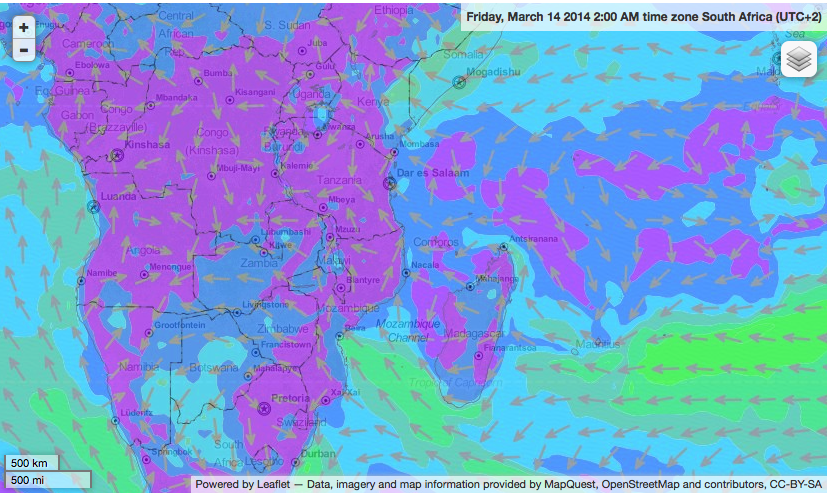Because Zimbabwe lays in the Southern Hemisphere, it's seasons are opposite of those countries in the Northern Hemisphere. For example, Zimbabwe experiences it's hottest weather from September to January and it's coldest weather from April to July. In contrast, The United States experiences it's hottest weather from June through September and it's coldest weather from December to February. This is important to know if one ever plans on visiting Zimbabwe, and can help decide on the appropriate clothing to bring and typical weather to expect. Knowing about Zimbabwe's rainy season (from November to March) is important as well because most activities take place outdoors, and heavy rain can ruin a day full of plans.
In 2014, the day of the winter solstice in the Southern Hemisphere is June 21st. During June, the average maximum temperature in Zimbabwe is 71.4 degrees fahrenheit and the average minimum temperature is 45.6 degrees. During this month, rain is the type of precipitation most likely to occur, due to the average minimum temperature being well above freezing. Because Zimbabwe exhibits monsoon-like rain patterns, June would be a dry month and a great time to visit.
In 2014, the day of the summer solstice in the Southern Hemisphere is December 21st. During December, the average maximum temperature in Zimbabwe is 81.2 degrees fahrenheit and the average minimum temperature is 62.6 degrees. Excluding extreme circumstances, the only type of precipitation in Zimbabwe during December is rain. December is in the middle of Zimbabwe's rainy season, in which the country receives most of it's rainfall.
In 2014, the day of the spring equinox in the Southern Hemisphere is September 23rd. During September, the average maximum temperature in Zimbabwe is 81.6 degrees fahrenheit and the average minimum temperature is 54.5 degrees. Average minimum temperatures are well above freezing so rain is the type of precipitation most likely to occur. September is on the borderline of the rainy season, so rain should be expected when traveling to Zimbabwe during this time.
In 2014, the day of the autumn equinox in the Southern Hemisphere is March 20th. During March, the average maximum temperature in Zimbabwe is 80.4 degrees fahrenheit and the minimum average temperature is 60.7 degrees. According to these temperatures, rain the the most common type of precipitation during March. Zimbabwe's latitude puts in the tropics, and due to the constant warmer temperatures closer to the equator, any type of precipitation besides rain is very uncommon.
According the the weather data gathered above, the best season to visit Zimbabwe would be during the winter months, from June to August. Because Zimbabwe does have a rainy season, one wants to avoid this time entirely and visit when the weather is reliably sunny, so there are many activities one can partake in. Popular activities in Zimbabwe are sightseeing and freshwater fishing. There are many national parks with tour guides year-around, and many of the animals and plants are unique to those regions in Africa. Popular national parks are Victoria Falls National Park, located on the western tip of Zimbabwe, and Hwange National Park, about an hour south of Victoria Falls. These National Parks provide beautiful landscapes, breathtaking natural phenomenon, and a safe place for large wild animals to inhabit. Lake Kariba lays on the northern border of Zimbabwe, and is the site of great freshwater fishing and fishing tours. Of course, fishing and sightseeing usually requires dry weather, so avoiding Zimbabwe's rainy season would be best.
There is very little potential weather hazards during winter season in Zimbabwe, as most of the extreme weather occurs during the exact opposite time of the year. Despite this, one can never fully predict weather, and should still be prepared for potential weather hazards. Zimbabwe is landlocked, so rain in large quantities are usually the cause of weather hazards. Flooding of rivers are the most common weather hazards, as well as sinkholes dues to extended periods of heavy rain. Because all of these weather hazards are caused by constant heavy rain, there is very little chance of weather hazards being a factor during a visit in the winter time. If one is looking to entirely avoid rain and a humid, hotter environment, Zimbabwe provides a perfect time of year to visit and have fun.
Devil's Pool in Victoria Falls National Park, Zimbabwe
(http://www.justmegawatt.com/images/imageassets/odd/devilspool/victoriafalls.jpg)
If excitement and adventure is stuck on your mind, visit Zimbabwe and have an unforgettable time.




